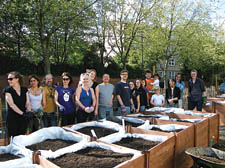|
|
 |
| |

Getting hands-on with vegetables in Camley Street |
‘Soil is the most precious thing’
With a little care, ‘derelict’ land gives big yields, says Tom Moggach
Just imagine it – King’s Cross as a food growing paradise: vineyards and veg plots, ripe pineapples harvested from rooftop greenhouses.
It sounds crazy, impossible even. But I wouldn’t bet against it, especially when a gentleman called Alex Smith is involved.
I met him last week, when I cycled down to his cereal factory on Camley Street, a few minutes from Saint Pancras station.
Alex runs a business called Alara Wholefoods, well known for its eco-credentials.
At first sight, it seemed an unlikely spot for food growing – a sprawl of warehouses next to the railway track, noisy with departing trains.
But it’s also home to three food growing projects – each offering inspiration and tips.
The first is the forest garden: a sliver of land by the train track. It was wasteland five years ago. Over one summer, Alex and others dug up 250 kilos of Japanese knotweed and collected five tonnes of rubbish.
Now it’s a garden for unusual plants and trees – around 50 species such as pineapple guava, Sharon fruit, mulberry and pomegranate. Three beehives buzz quietly at one far end. It’s a permaculture garden, designed to maximise yields by growing in layers – a carpet of wild strawberries, for example, bears its fruit before the pear tree above.
My favourite shrub there is the Japanese wineberry. It’s an underrated edible plant with orangey-red, bristly branches and tangy sweet fruit. Buy one to grow alongside your raspberries (www. kore wildfruitnursery.co.uk).
The second project is the vineyard: 30 vines planted on a south-facing slope outside the warehouse. The right grape varieties will thrive in the London climate. If you’ve got the space, why not plant a few? Try the Urban Wine Company (www.urbanwineco.com).
The third project is a new veg plot next to Camley Street itself. Funded with help from the council, it’s a row of wooden raised beds tended by three local groups: the London Irish Centre, Camden Chinese Community and the Hopscotch Asian Women’s Centre.
Here, the philosophy is to grow on top of the land – a useful approach to get growing quickly, or if the soil itself is contaminated.
By inviting local people to care for the plot, Alex saves maintenance costs – a good argument to persuade your boss if you’d like to do something similar. Staff can also swap a shift on the production line to grow their own.
Over near Swiss Cottage, residents on the Alexandra and Ainsworth estate are using a similar tactic. They have started to fill large builders’ bags with compost to grow on top of concrete paving. For a similar but more established project, check out Vacant Lot in Shoreditch.
Back at the Alara forest garden, Smith rolls up his shirt sleeves to scythe the tall grass. “If you’ve got a piece of ground anywhere that’s uncared for, really value it,” he says. “Soil is the most precious thing there is.”
He has a dream to help build an anaerobic digester nearby – new technology for composting green waste. One byproduct, he explains, is “digestate”, a kind of “rocket fuel” for growing healthy veggies.
The heat from the process could help warm a greenhouse above: “We’ll have our pineapples and bananas growing on top,” says Smith, with a glint in his eye. Now that’s one harvest I can’t wait to try.
•
|

|
 |
Your comments:
The Lenkiewicz exhibition is stunning from the remarkable St Eustace sculpture to the drawings featuring unicorns, tigers and Elvis! The skeletons and skulls were my particular favourite along with the octopus drowning the Titanic. The surroundings are fabulous; the Pite architecture lends itself so well to the mood. I admit I have a particular fondness for
the building having worked there for 26 years.
J. Trend-Hill
|
|
 |
|

